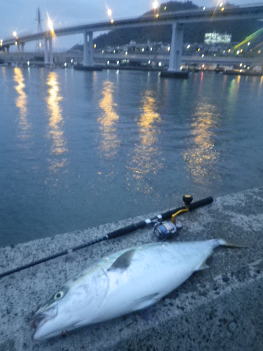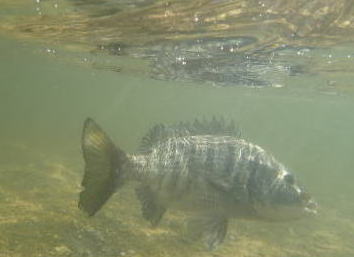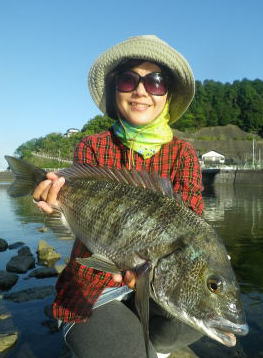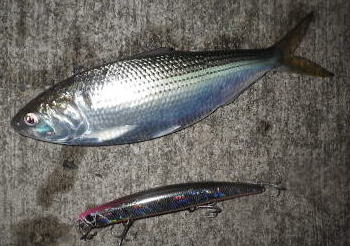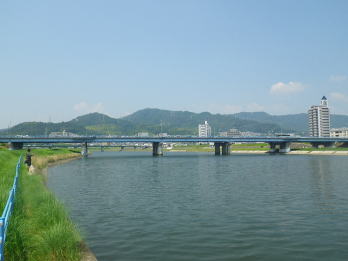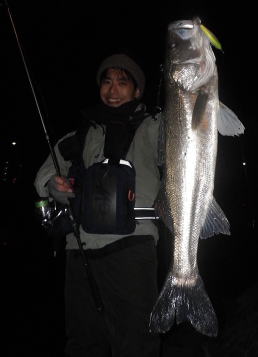Other Games
Spinning rod, which I picked up only as a diversion, turned out to be an
eye opener. The new tackle, the new methods, and most importantly, the
by far wider coverage of fishing potential thrilled me. Apart from seabass
and breams, there was such a surprising by catch as this - Buri, a close
kin of Kingfish, came assaulting the hapless Konoshiro right at our door
steps. Looking forward to the next season hunting our new and old quarries
high and low.
- Next
By mid June, the algae had all gone making fishing easy. But Breams had
become more selective. Even after following the fly several meters, they
could still refuse it at the very end. Eeven when they did nibble, often
the hook caught them by just the skin of their bill and didn't bring the
fish to the net.
July and August saw a mild recovery of their appetite - after spawn I presume
- but for some reason the average size dropped to 38cm, with few fish above
45cm mark. This is a theme for further observation next year.
Sayuri was good at this game and nailed down this biggest bream of ours
to date - 50.3cm.
While it lacks the finesse pleasure of Flyfishing, lure casting is fun
in its own right, and I must admit the average size you catch this way
is bigger than those on crab flies.
September sees gradual drop of the temperature and the weather still good,
making for a pleasant fishing. Feeling the change of the season perhaps,
breams became less selective to well presented flies too.
Rhey became more interested in the bait fish, too. As the schools of small
baitfish comes into the flat, or the spawned out Ayu floats downr, breams
showed their predatory instinct enough to push seabass away.
Breams are wary fish normally. But the are opportunistic enough to grab
at bait fish half their own length at times, especially when those tasty
Ayu is on the table.
They are intelligent hunters too. They form a pack of 5-6 fish, round up
the bait fish to shallow corners for the moment of kill. A good angler
shouldn't waste time blind casting. You wait for that moment when all hell
breaks loose, then shoot your fishy bullet right into the carnage that
typically lasts for 5-10 seconds only.
Japan in August is very hot. The air heats up to 37c, while the water to
32c. Wading wet, I felt as if bathing in a bath.
Not as willing as the spring fish, but they remained active even at the
height of the summer and, once hooked, proved much more powerful than the
spawners in May.
All in all, we spent some 20 days on bream fishing, landing 74 fish in
total. Of which, 10 fish caught on spinning.
As for sight fishing on fly, Sayuri and I (always sharing one rod between us) we had 150bites, 112hook ups, and 64fish caught. Breams have very solid jaws and they struggle more like a brown trout than a rainbow, which results in fair number of fish lost as you can see from the stats. Must explore more productive flies and methods in the seasons to come.
May is the most pleasant time of the year - not too warm not too cold.
The fishery is easy to wade around, so we could go fishing nursing the
little one - she never allowed us to concentrate though.
As in most parts of the inland sea, fluffy green algae sprout as the water
warms up. A nuisance as we had to clean the fly at every cast, but breams
were very active, feeding on creatures that apparently live in the weeds.,
From our experience in the previous autumn, Breams becomes less active
once the water temp drops below 20c. Assuming the reverse of the principle,
we focused our effort in the afternoon when the water floods in on the
sun baked flat. And sure enough, their came feeding with such gusto, and
Sayuri was to nail down a 48cm big bream within the first half an hour.
Great fishing continued through the afternoon, and in fact, through to
the first half of June. This is their pre-spawning season and the big fish
become more aggressive needing protein. What they didn't know was that
our crab flies didn't contain any protein.
On Bream Games
Discovery of bream fishery in September '12 was the corner stone in my
SW renaissance. 2013 was the first full year to see its full potential,
and with pretty good successes now looking back.
March and April did not give us the conditions needed - sunny day with
small tide. So we had to wait till early May.
Looking back on my log, 73 total catch may seem modest compared with Tokyo
bay. But the rate of lunker fish, say, 70cm and above is by far higher
here in Hiroshima. Learning the seasonality of our waters, I am confident
I can improve the success rate further.
I invited Sayuri to fish with me only 6 times this year - 6 times that
I thought the condition was good. As a result, she landed three trophy
fish topped by this 90cm whopper. This is a tell tale indication that seabass
fishing is a strategic game of data analysis.
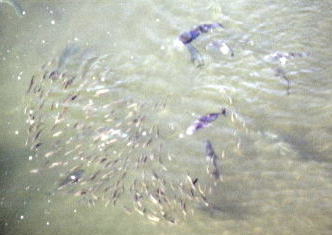
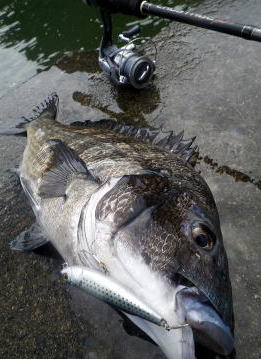
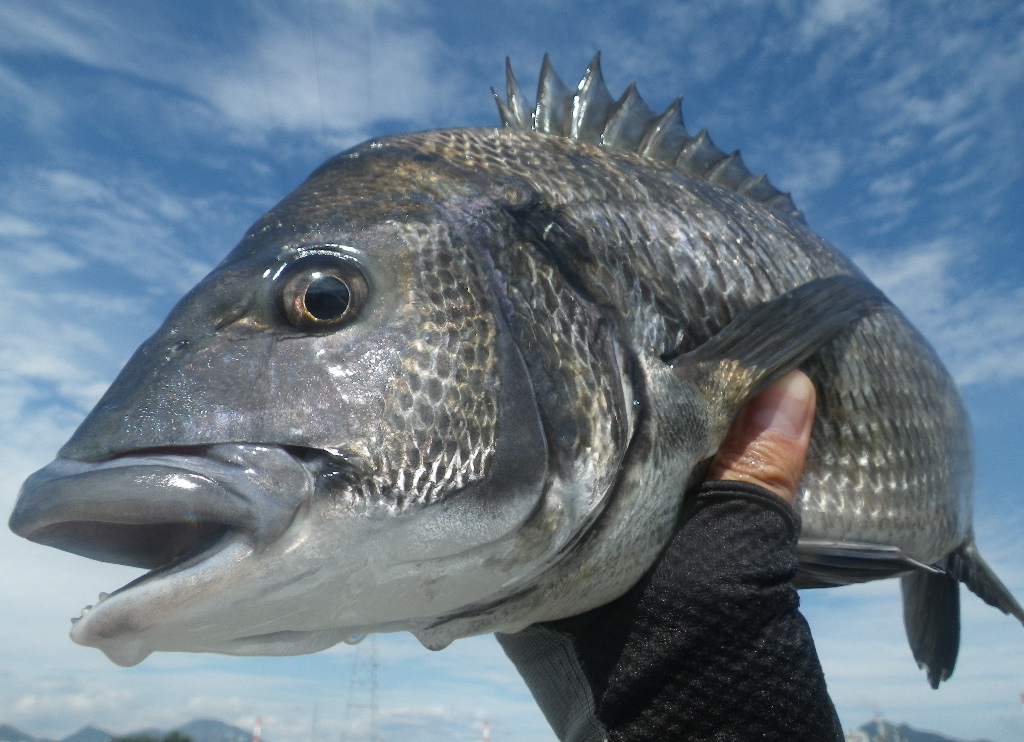
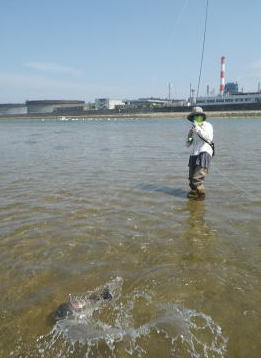
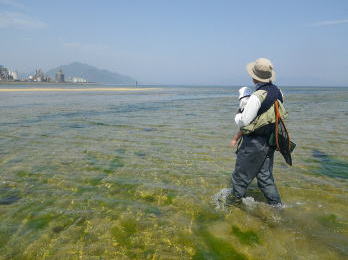
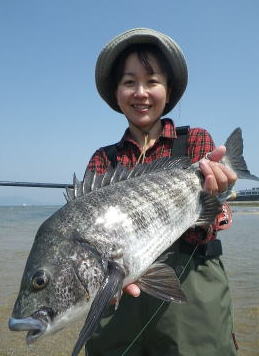

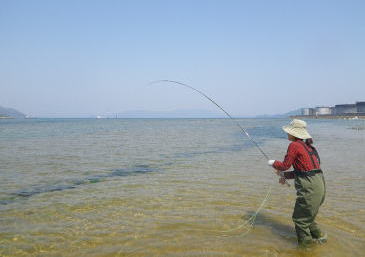
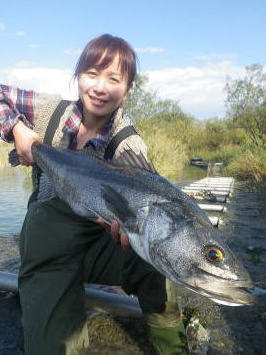
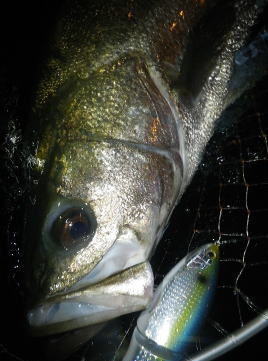
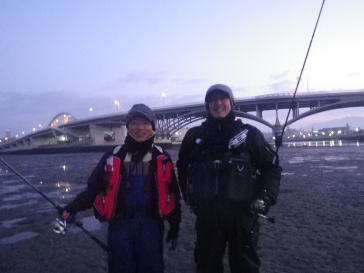
October sees the start of Konoshiro's spawning run. They live in the brackish
water but come into the rivers as the water cools down to 18c. They form
giant schools and at times fills up the entire length of the river to the
extent no lures can swim through it. Throw in big hungry seabass into the
equation, you get spectacular carnage in our urban waterways.
Smaller Konoshiro of 15cm class show up first, but they grow in size as
the autumn deepens, to reach 30cm by Christmas. We are forced to throw
giant lures though casting becomes a drill.
The critical challenge of this game is to follow the movement of Konoshiro
schools. Here in Hiroshima tide can go up and down by 4meters in 6 hours,
which could carry the bait fish schools miles up or down. As Konoshiro
tend to swim not directly on the surface, they are difficult to spot after
dark, therefore daytime scouting plays an important role too.
Highlight of the season was a colossal battle with a 90cm lunker in central
Hiroshima. I stalked on it in a inflatable kayak to throw a big lure deep
into the shadows of a big bridge.
By mid December Konoshiro schools became thinner. Filling its place was
garfish but they are much much harder to imitate with hard lures. My friends
and I spent many a frustrating nights - seabass boiling everywhere but
none biting at our imitations.
With Nakajimasan and Mikamisan, I went out quite a few nights thru to the morning, if only to cherish the fleeing memory of exciting games of the seasons past.
Contrary to my intuition, seabass fishing was slow when the flood is in
full swing. Being ambush predator, they may not be able to chase the baits
when the current is too strong. It is when the flood starts to settle,
but the water still slightly colored, that's when the party starts.
Sayuri fared well to catch this trophy fish of 88cm, and right at the very
center of Hiroshima city!
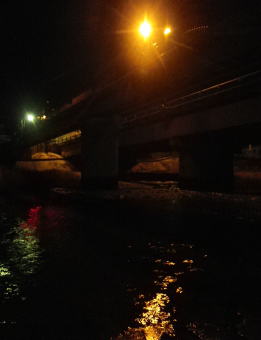
September is a month of typhoon. The overheated land and rivers welcomed
the fresh supply of rain water. With that as a trigger, Ayu, our indigenous
trout, starts migrating down the river. Seabass are the apex predator of
inshore waters and they wouldn't miss the feasting opportunities. I had
the most eventful fishing in this period, catching lunker fish beyond 70cm
mark one out of every 3 outing.
Big seabass are focused on Ayu so matching the bait size is critical. Plugs
around 14cm are the way to go. They are smart grown up fish, locating their
ambush spot and accuracy at the first cast is paramount. My good friend
and Yokohama's top seabass guide, Okamotosan, nailed down this 80cm trophy
fish.
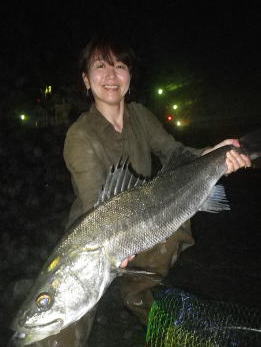
Spring. From mid April to end May sees the migration of baby Ayu - a distant
kin to trout family indigenous to Japan. Ohta river is one of the big producer
of Ayu and every seabass loves Ayu for a good tasty reason.
Once the water warmed up to 12c., they come into the river with every rising
tide. Once the water starts to drain, those hapless little Ayu became easy
prey to the ambushing predators. Catching them wasn't always easy - often
the baits were too small and too many. I managed one big fish on a lure,
and dropped one on a fly. Other than that, I had to put up with many a
frustrating nights with lots of feeding fish but not a nibble. Concurring
the ''baby ayu pattern'' is a task to be worked on.
August is the hottest month in Japan. Unless thunderstorms come to relieve
us, unbearably hot for us the humans and for the basses. At around 30c,
the water gets depleted with Oxygen, and the only sign of life in the water
were schools of ugly mullets gasping for air.
I went scouting around braving the heat, but after 22 successive fishless
outing that went on from late July to early Sept,, I had to accept the
fact there're better ways to enjoy the summer.
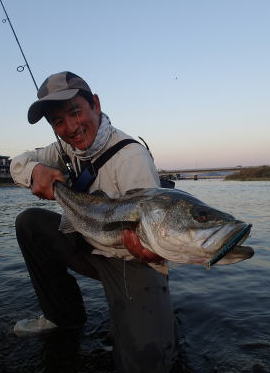
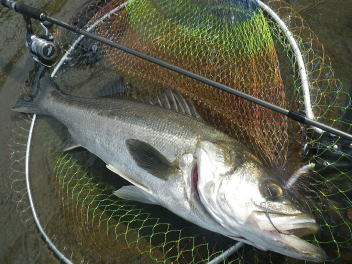
Since I took up flyfishing 20 years ago, I had been away from the spinning
gear except on the occasional blue water outings. Meanwhile the advancement
of spinning tackle was phenomenal, which kept me at bay even though I was
not entirely ignoring the SW scenes. It was my friend and lure fishing
mentor Nakajima, whe helped my come back with advice and on site guidance.
This seabass needed not to feel ashamed snared by the state of the art
outfit in Nakajimasan's capable hands.
On Seabass Games
Hiroshima and Yamaguchi are blessed with seabass waters. Observation of
the seasonal patterns are critical for the success. Let me take you though
them with brief month by month summaries.
February and March can see the sea teeming with baby squids. They stay
on the bottom during the day, but comes up to surface after dark lured
by the city lights. Adult seabass, that spawned in the deeper part of the
sea, come back to shallows to feast on this easy meals.
Hiroshima's pro shop FeeD operates a small charter boat. Lure fishing takes upper hand but fly fishing
has its own moment when seabass is fixated to slow drifting chewy snacks.
June is the wettest months in this part of the world and dramatic floods
are not uncommon. While they pose danger to the riverside communities,
they present great opportunities for us anglers..
After nearly one whole month's fishless outing, I was to hit a jackpot
on June 23rd in the aftermath of a big flood. The following 2 weeks saw
me landing numbers of good fish up to 80cms, often in a broad daylight!
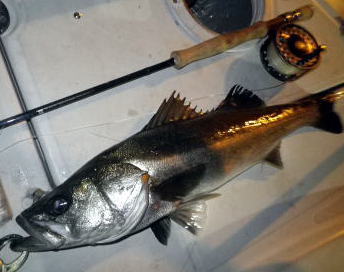

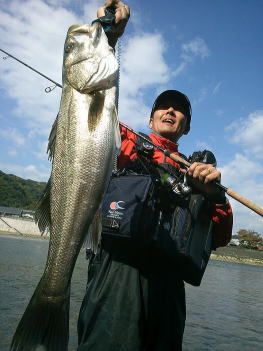
Through the coldest time of the year from January to February, they depend
on small shrimps and micro baitfish. They tend to hover around under the
street lights, especially upstream of the bridges.
The air temperature at night averages at 4c, cold enough even for the hard
core. But seabass can be surprisingly active as long as the microbaits
are around. Feast could happen in icy cold water of 2c, but could mysteriously
shut down when the water warmed up to 7c. Drifting a small sinking pencil
(such as Marib68) right underneath the surface was the best way to see
if the night is hot or not.
Rain or shine, in scorching heat or in snow storms the salty temptation
kept me going. The chart above counts 158 fishing days in total. Often
I fished on though midnight so technically I must have fished more like
200 days. I can never have enough when it comes to fishing but, to be honest,
I at times came pretty close to that.
From February onward I went out 10 days a month in search of seabass. Once
the bream season opened up in May, every sunny weekend with smaller tide
had to be dedicated to them. Squid runs in early summer and in autumn,
snapper jigging and blue water games in summer. I couldn't go greet the
trout as often - I hope they would forgive me.

While my home streams in the north Hiroshima is an hour and half's drive away, the nearest seabass point is 5 minutes by bicycle. And what fascinated me most is the fact SW fishing is a 'data fishing'. Analytical mind is the key to the success. And that tendency was far more evident than the freshwater game I had become almost too familiar with.
Looking back, it was an absolute fishing year 2013.
Facing the change of family status, I was forced to explore opportunities
in my neighborhood. With some advice of lure fishing friends, I succeeded
in unveiling respectable bream and seabass fisheries at my doorstep.
2013 was to be the first year to study its full seasonal potentials. Every
day and every night gave me a fresh learning or two, and yet more clues
to crack the mystery of the saltwater fishing.
 '13 Journal
'13 Journal